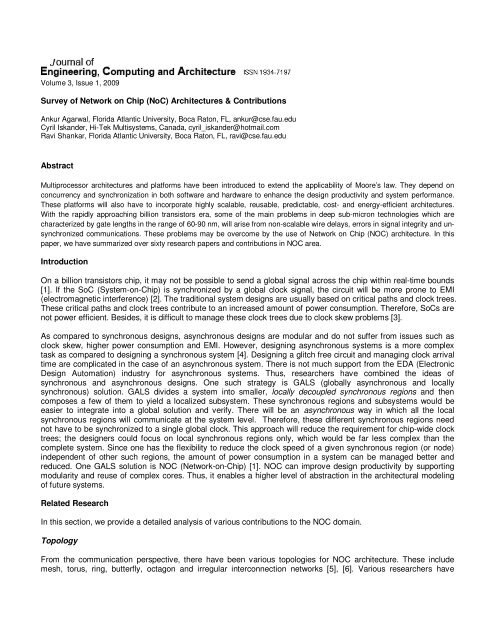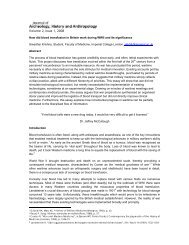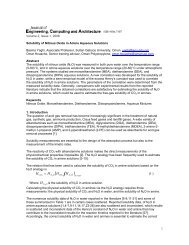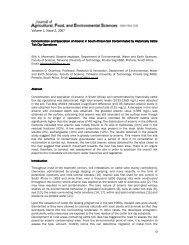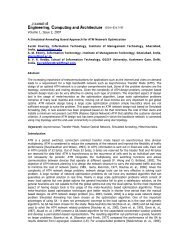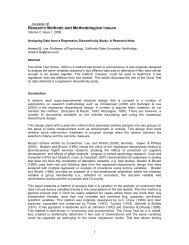Survey of Network on Chip (NoC) Architectures & Contributions ...
Survey of Network on Chip (NoC) Architectures & Contributions ...
Survey of Network on Chip (NoC) Architectures & Contributions ...
You also want an ePaper? Increase the reach of your titles
YUMPU automatically turns print PDFs into web optimized ePapers that Google loves.
Volume 3, Issue 1, 2009<br />
<str<strong>on</strong>g>Survey</str<strong>on</strong>g> <str<strong>on</strong>g>of</str<strong>on</strong>g> <str<strong>on</strong>g>Network</str<strong>on</strong>g> <strong>on</strong> <strong>Chip</strong> (<strong>NoC</strong>) <strong>Architectures</strong> & C<strong>on</strong>tributi<strong>on</strong>s<br />
Ankur Agarwal, Florida Atlantic University, Boca Rat<strong>on</strong>, FL, ankur@cse.fau.edu<br />
Cyril Iskander, Hi-Tek Multisystems, Canada, cyril_iskander@hotmail.com<br />
Ravi Shankar, Florida Atlantic University, Boca Rat<strong>on</strong>, FL, ravi@cse.fau.edu<br />
Abstract<br />
Multiprocessor architectures and platforms have been introduced to extend the applicability <str<strong>on</strong>g>of</str<strong>on</strong>g> Moore’s law. They depend <strong>on</strong><br />
c<strong>on</strong>currency and synchr<strong>on</strong>izati<strong>on</strong> in both s<str<strong>on</strong>g>of</str<strong>on</strong>g>tware and hardware to enhance the design productivity and system performance.<br />
These platforms will also have to incorporate highly scalable, reusable, predictable, cost- and energy-efficient architectures.<br />
With the rapidly approaching billi<strong>on</strong> transistors era, some <str<strong>on</strong>g>of</str<strong>on</strong>g> the main problems in deep sub-micr<strong>on</strong> technologies which are<br />
characterized by gate lengths in the range <str<strong>on</strong>g>of</str<strong>on</strong>g> 60-90 nm, will arise from n<strong>on</strong>-scalable wire delays, errors in signal integrity and unsynchr<strong>on</strong>ized<br />
communicati<strong>on</strong>s. These problems may be overcome by the use <str<strong>on</strong>g>of</str<strong>on</strong>g> <str<strong>on</strong>g>Network</str<strong>on</strong>g> <strong>on</strong> <strong>Chip</strong> (NOC) architecture. In this<br />
paper, we have summarized over sixty research papers and c<strong>on</strong>tributi<strong>on</strong>s in NOC area.<br />
Introducti<strong>on</strong><br />
On a billi<strong>on</strong> transistors chip, it may not be possible to send a global signal across the chip within real-time bounds<br />
[1]. If the SoC (System-<strong>on</strong>-<strong>Chip</strong>) is synchr<strong>on</strong>ized by a global clock signal, the circuit will be more pr<strong>on</strong>e to EMI<br />
(electromagnetic interference) [2]. The traditi<strong>on</strong>al system designs are usually based <strong>on</strong> critical paths and clock trees.<br />
These critical paths and clock trees c<strong>on</strong>tribute to an increased amount <str<strong>on</strong>g>of</str<strong>on</strong>g> power c<strong>on</strong>sumpti<strong>on</strong>. Therefore, SoCs are<br />
not power efficient. Besides, it is difficult to manage these clock trees due to clock skew problems [3].<br />
As compared to synchr<strong>on</strong>ous designs, asynchr<strong>on</strong>ous designs are modular and do not suffer from issues such as<br />
clock skew, higher power c<strong>on</strong>sumpti<strong>on</strong> and EMI. However, designing asynchr<strong>on</strong>ous systems is a more complex<br />
task as compared to designing a synchr<strong>on</strong>ous system [4]. Designing a glitch free circuit and managing clock arrival<br />
time are complicated in the case <str<strong>on</strong>g>of</str<strong>on</strong>g> an asynchr<strong>on</strong>ous system. There is not much support from the EDA (Electr<strong>on</strong>ic<br />
Design Automati<strong>on</strong>) industry for asynchr<strong>on</strong>ous systems. Thus, researchers have combined the ideas <str<strong>on</strong>g>of</str<strong>on</strong>g><br />
synchr<strong>on</strong>ous and asynchr<strong>on</strong>ous designs. One such strategy is GALS (globally asynchr<strong>on</strong>ous and locally<br />
synchr<strong>on</strong>ous) soluti<strong>on</strong>. GALS divides a system into smaller, locally decoupled synchr<strong>on</strong>ous regi<strong>on</strong>s and then<br />
composes a few <str<strong>on</strong>g>of</str<strong>on</strong>g> them to yield a localized subsystem. These synchr<strong>on</strong>ous regi<strong>on</strong>s and subsystems would be<br />
easier to integrate into a global soluti<strong>on</strong> and verify. There will be an asynchr<strong>on</strong>ous way in which all the local<br />
synchr<strong>on</strong>ous regi<strong>on</strong>s will communicate at the system level. Therefore, these different synchr<strong>on</strong>ous regi<strong>on</strong>s need<br />
not have to be synchr<strong>on</strong>ized to a single global clock. This approach will reduce the requirement for chip-wide clock<br />
trees; the designers could focus <strong>on</strong> local synchr<strong>on</strong>ous regi<strong>on</strong>s <strong>on</strong>ly, which would be far less complex than the<br />
complete system. Since <strong>on</strong>e has the flexibility to reduce the clock speed <str<strong>on</strong>g>of</str<strong>on</strong>g> a given synchr<strong>on</strong>ous regi<strong>on</strong> (or node)<br />
independent <str<strong>on</strong>g>of</str<strong>on</strong>g> other such regi<strong>on</strong>s, the amount <str<strong>on</strong>g>of</str<strong>on</strong>g> power c<strong>on</strong>sumpti<strong>on</strong> in a system can be managed better and<br />
reduced. One GALS soluti<strong>on</strong> is NOC (<str<strong>on</strong>g>Network</str<strong>on</strong>g>-<strong>on</strong>-<strong>Chip</strong>) [1]. NOC can improve design productivity by supporting<br />
modularity and reuse <str<strong>on</strong>g>of</str<strong>on</strong>g> complex cores. Thus, it enables a higher level <str<strong>on</strong>g>of</str<strong>on</strong>g> abstracti<strong>on</strong> in the architectural modeling<br />
<str<strong>on</strong>g>of</str<strong>on</strong>g> future systems.<br />
Related Research<br />
In this secti<strong>on</strong>, we provide a detailed analysis <str<strong>on</strong>g>of</str<strong>on</strong>g> various c<strong>on</strong>tributi<strong>on</strong>s to the NOC domain.<br />
Topology<br />
From the communicati<strong>on</strong> perspective, there have been various topologies for NOC architecture. These include<br />
mesh, torus, ring, butterfly, octag<strong>on</strong> and irregular interc<strong>on</strong>necti<strong>on</strong> networks [5], [6]. Various researchers have
exploited these different NOC topologies for their NOC implementati<strong>on</strong>s. Kim et al. have used a star-based NOC<br />
that communicated using the principle <str<strong>on</strong>g>of</str<strong>on</strong>g> CDMA (Code Divisi<strong>on</strong> Multiple Access) [7]; Adriahantenaina et al.<br />
proposed a tree-based implementati<strong>on</strong> <str<strong>on</strong>g>of</str<strong>on</strong>g> NOC [8], where each node in the tree behaves as a router in NOC;<br />
Pande et al. compared various network topologies for interc<strong>on</strong>necti<strong>on</strong> networks in terms <str<strong>on</strong>g>of</str<strong>on</strong>g> latency, throughput, and<br />
energy dissipati<strong>on</strong> [6]. Several researchers have suggested that a 2-D mesh architecture for NOC will be more<br />
efficient in terms <str<strong>on</strong>g>of</str<strong>on</strong>g> latency, power c<strong>on</strong>sumpti<strong>on</strong> and ease <str<strong>on</strong>g>of</str<strong>on</strong>g> implementati<strong>on</strong>, as compared to other topologies. The<br />
Octag<strong>on</strong> NOC dem<strong>on</strong>strated in [9] is an example <str<strong>on</strong>g>of</str<strong>on</strong>g> a novel regular NOC topology.<br />
Router Architecture<br />
NOC architectures are based <strong>on</strong> packet-switched networks. This has led to new and efficient principles for design<br />
<str<strong>on</strong>g>of</str<strong>on</strong>g> routers for NOC [10]. Assume that a router for the mesh topology has four inputs and four outputs from/to other<br />
routers, and another input and output from/to the <str<strong>on</strong>g>Network</str<strong>on</strong>g> Interface (NI). Routers can implement various<br />
functi<strong>on</strong>alities - from simple switching to intelligent routing. Since embedded systems are c<strong>on</strong>strained in area and<br />
power c<strong>on</strong>sumpti<strong>on</strong>, but still need high data rates, routers must be designed with hardware usage in mind. For<br />
circuit-switched networks, routers may be designed with no queuing (buffering). For packet-switched networks,<br />
some amount <str<strong>on</strong>g>of</str<strong>on</strong>g> buffering is needed, to support bursty data transfers. Such data originate in multimedia<br />
applicati<strong>on</strong>s such as video streaming. Buffers can be provided at the input, at the output, or at both input and output<br />
[11].<br />
Various designs and implementati<strong>on</strong>s <str<strong>on</strong>g>of</str<strong>on</strong>g> router architectures based <strong>on</strong> different routing strategies have been<br />
proposed in the literature. Wolkotte et al. proposed a circuit switched router architecture for NOC [12], while Dally<br />
and Towles proposed a packet switched router architecture [13]. Albenes and Frederico provided a wormholebased<br />
packet forwarding design for a NOC switch [14].<br />
Routing Protocol<br />
Routing Algorithms<br />
Number <str<strong>on</strong>g>of</str<strong>on</strong>g><br />
Destinati<strong>on</strong>s<br />
Unicast Routing<br />
Multicast Routing<br />
Centralized Routing Source Routing Distributed Routing Multiphase Routing<br />
Routing Decisi<strong>on</strong>s<br />
Implementati<strong>on</strong><br />
Adaptability<br />
Lookup Table<br />
Deterministic Routing<br />
Finite State Machines<br />
Adaptive Routing<br />
Progressiveness<br />
Minimality<br />
Number <str<strong>on</strong>g>of</str<strong>on</strong>g> Paths<br />
Progressive<br />
Pr<str<strong>on</strong>g>of</str<strong>on</strong>g>itable<br />
Complete<br />
Figure 1. Routing algorithms.<br />
Backtracking<br />
Misrouting<br />
Partial<br />
Routing algorithms can be classified in various ways, as shown in Figure 1. In unicast routing, the packets have a<br />
single destinati<strong>on</strong>, while in the case <str<strong>on</strong>g>of</str<strong>on</strong>g> multicast routing, the packets have multiple destinati<strong>on</strong>s. For <strong>on</strong>-chip<br />
communicati<strong>on</strong>, unicast routing strategies seem to be a practical approach due to the presence <str<strong>on</strong>g>of</str<strong>on</strong>g> point-to-point
communicati<strong>on</strong> links am<strong>on</strong>g various comp<strong>on</strong>ents inside a chip. Based <strong>on</strong> the routing decisi<strong>on</strong>, unicast routing can<br />
be further classified into four classes: centralized routing, source routing, distributed routing and multiphase routing.<br />
In centralized routing, a centralized c<strong>on</strong>troller c<strong>on</strong>trols the data flow in a system. In case <str<strong>on</strong>g>of</str<strong>on</strong>g> source routing, the<br />
routing decisi<strong>on</strong>s are taken at the point <str<strong>on</strong>g>of</str<strong>on</strong>g> data generati<strong>on</strong>, while in distributed routing, the routing decisi<strong>on</strong>s are<br />
determined as the packets/flits flow through the network. The hybrid <str<strong>on</strong>g>of</str<strong>on</strong>g> the two schemes, source and destinati<strong>on</strong><br />
routing, is called multiphase routing.<br />
Routing algorithms can also be defined based <strong>on</strong> their implementati<strong>on</strong>: lookup table and Finite State Machine<br />
(FSM). Lookup table routing algorithms are more popular in implementati<strong>on</strong>. They are implemented in s<str<strong>on</strong>g>of</str<strong>on</strong>g>tware,<br />
where a lookup table is stored in every node. We can change the routing algorithm by replacing the entries <str<strong>on</strong>g>of</str<strong>on</strong>g> the<br />
lookup table. FSM based routing algorithms may be implemented either in s<str<strong>on</strong>g>of</str<strong>on</strong>g>tware or in hardware.<br />
These routing algorithms may further be classified based <strong>on</strong> their adaptability. Deterministic routing always follows<br />
a deterministic path <strong>on</strong> the network. Examples <str<strong>on</strong>g>of</str<strong>on</strong>g> such routing algorithms are XY routing, North first, South first,<br />
East first, and West first. Adaptive routing algorithms need more informati<strong>on</strong> about the network to avoid c<strong>on</strong>gested<br />
paths in the network. These routing algorithms are obviously more complex to implement, thus, are more expensive<br />
in area, cost and power c<strong>on</strong>sumpti<strong>on</strong>. Therefore, we must c<strong>on</strong>sider a right QoS (Quality-<str<strong>on</strong>g>of</str<strong>on</strong>g>-Service) metric before<br />
employing these algorithms.<br />
Routing algorithms can be fault-tolerant algorithms such as backtracking. In case <str<strong>on</strong>g>of</str<strong>on</strong>g> progressive algorithms, a<br />
channel is reserved before a flit is forwarded. Some routing algorithms send packets/flits <strong>on</strong>ly in the directi<strong>on</strong> that is<br />
nearer to the destinati<strong>on</strong>. These routing algorithms are referred as pr<str<strong>on</strong>g>of</str<strong>on</strong>g>itable algorithms. A misrouting algorithm<br />
may forward a packet/flit away from the destinati<strong>on</strong> as well. Based <strong>on</strong> the number <str<strong>on</strong>g>of</str<strong>on</strong>g> available routing paths, routing<br />
algorithms can be finally classified as complete and partial routing algorithms.<br />
Various routing algorithms have been proposed for the NOC. Most researchers suggested static routing algorithms<br />
and performed communicati<strong>on</strong> analysis based <strong>on</strong> the static behavior <str<strong>on</strong>g>of</str<strong>on</strong>g> NOC processes, thus, determining the<br />
static routing for NOC. Siebenborn et al. and Hu et al. used a CDG (Communicati<strong>on</strong> Dependency Graph) to<br />
analyze inter-process communicati<strong>on</strong>s [15] [16].<br />
Most NOC implementati<strong>on</strong>s used either XY routing or street sign routing algorithms. In [17], a comparis<strong>on</strong> <str<strong>on</strong>g>of</str<strong>on</strong>g><br />
deterministic (dimensi<strong>on</strong>-order) and adaptive routing algorithms for mesh, torus, and cube networks was presented.<br />
Mello et al. researched the performance <str<strong>on</strong>g>of</str<strong>on</strong>g> minimal routing protocol in NOC [18]. They c<strong>on</strong>cluded that the minimal<br />
routing provided better results than adaptive routing for <strong>on</strong>-chip-communicati<strong>on</strong>s, as the adaptive routing<br />
c<strong>on</strong>centrates <strong>on</strong> the traffic in the center <str<strong>on</strong>g>of</str<strong>on</strong>g> the NOC.<br />
Switching Techniques<br />
Switching<br />
Techniques<br />
Circuit Switching<br />
Packet Switching<br />
Wormhole<br />
Switching<br />
S&F<br />
Switchin<br />
Figure 2. Switching techniques.<br />
Virtual Cut<br />
Through<br />
Switching techniques can be classified based <strong>on</strong> network characteristics. Circuit switched networks reserve a<br />
physical path before transmitting the data packets, while packet switched networks transmit the packets without<br />
reserving the entire path. Packet switched networks can further be classified as Wormhole, Store and Forward<br />
(S&F), and Virtual Cut Through Switching (VCT) networks (see Figure 2). In Wormhole switching networks, <strong>on</strong>ly the<br />
header flit experiences latency. Other flits bel<strong>on</strong>ging to the same packet simply follow the path taken by the header
flit. If the header flit is blocked then the entire packet is blocked. It does not require any buffering <str<strong>on</strong>g>of</str<strong>on</strong>g> the packet.<br />
Therefore, the size <str<strong>on</strong>g>of</str<strong>on</strong>g> the chip drastically reduces. However, the major drawback <str<strong>on</strong>g>of</str<strong>on</strong>g> this switching technique is a<br />
higher latency. Thus, it is not a suitable switching technique for real-time data transfers. Al-Tawil et al. provided a<br />
well-structured survey <str<strong>on</strong>g>of</str<strong>on</strong>g> Wormhole Routing techniques and its comparis<strong>on</strong> with other switching techniques [19].<br />
S&F switching forwards a packet <strong>on</strong>ly when there is enough space available in the receiving buffer to hold the<br />
entire packet. Thus, there is no need for dividing a packet into flits. This reduces the overhead, as it does not<br />
require circuits such as a flit builder, a flit decoder, a flit stripper and a flit sequencer. Nevertheless, such a<br />
switching technique requires a large amount <str<strong>on</strong>g>of</str<strong>on</strong>g> buffer space at each node. Thus, it may not be a feasible soluti<strong>on</strong><br />
for embedded applicati<strong>on</strong>s. The CLICHÉ implementati<strong>on</strong> <str<strong>on</strong>g>of</str<strong>on</strong>g> a NOC is an example <str<strong>on</strong>g>of</str<strong>on</strong>g> store-and-forward switching [2].<br />
Millberg et al. employed this switching technique in their Nostrum NOC implementati<strong>on</strong> [20]. In VCT switching, a<br />
packet is forwarded to the next router as so<strong>on</strong> as there is enough space to hold the packet. However, unlike S&F,<br />
the VCT algorithm divides a packet into flits, which may be further divided into phits. Therefore, it has the same<br />
buffer requirement as S&F. N<strong>on</strong>e <str<strong>on</strong>g>of</str<strong>on</strong>g> the NOC implementati<strong>on</strong>s has adopted this switching technique in their<br />
implementati<strong>on</strong>.<br />
Ad-hoc switching techniques can be also developed by combining different switching techniques. For instance, VCs<br />
can be used for each class <str<strong>on</strong>g>of</str<strong>on</strong>g> traffic, while each channel is operated as per the principles <str<strong>on</strong>g>of</str<strong>on</strong>g> circuit switching. The<br />
Ethereal [10], [21] and M<strong>on</strong>go NOC implementati<strong>on</strong>s use such a combinati<strong>on</strong> <str<strong>on</strong>g>of</str<strong>on</strong>g> techniques [22], [23].<br />
Flow C<strong>on</strong>trol<br />
Flow c<strong>on</strong>trol determines how network resources, such as channel bandwidth, buffer capacity, and c<strong>on</strong>trol state, are<br />
allocated to a packet traversing the network. The flow c<strong>on</strong>trol may be buffered or bufferless (see Figure 3).<br />
The Bufferless Flow C<strong>on</strong>trol has more latency and less throughput than thr Buffered Flow C<strong>on</strong>trol. The Buffered<br />
Flow C<strong>on</strong>trol can be further categorized into Credit Based Flow C<strong>on</strong>trol, ACK/NACK Flow C<strong>on</strong>trol, STALL/GO Flow<br />
C<strong>on</strong>trol, T-Error Flow C<strong>on</strong>trol, and Handshaking Signal based Flow C<strong>on</strong>trol.<br />
Flow C<strong>on</strong>trol<br />
Bufferless Flow<br />
C<strong>on</strong>trol<br />
(Mainly used for<br />
circuit switched<br />
networks)<br />
Buffered Flow<br />
C<strong>on</strong>trol<br />
(Mainly used for<br />
packet switched<br />
networks)<br />
Credit<br />
Based<br />
Flow<br />
C<strong>on</strong>trol<br />
Handshakin<br />
g Signals<br />
ACK/NAC<br />
K Flow<br />
C<strong>on</strong>trol<br />
STALL/GO<br />
Flow<br />
C<strong>on</strong>trol<br />
T-Error<br />
Flow<br />
C<strong>on</strong>trol<br />
Figure 3. Flow c<strong>on</strong>trol techniques.<br />
In Credit Based Flow C<strong>on</strong>trol, an upstream node keeps count <str<strong>on</strong>g>of</str<strong>on</strong>g> data transfers, and thus the available free slots are<br />
termed as credits. Once the transmitted data packet is either c<strong>on</strong>sumed or further transmitted, a credit is sent back.<br />
Bolotin et al. used Credit Based Flow C<strong>on</strong>trol in QNOC [24], [25].<br />
In Handshaking Signal Based Flow C<strong>on</strong>trol, a VALID signal is sent whenever a sender transmits any flit. The<br />
receiver acknowledges by asserting a VALID signal after c<strong>on</strong>suming the data flit. Zeferino et al. used handshaking<br />
signals in their SoCIN NOC implementati<strong>on</strong> [26].<br />
In the ACK/NACK protocol a copy <str<strong>on</strong>g>of</str<strong>on</strong>g> a data flit is kept in a buffer until an ACK signal is received. On asserti<strong>on</strong> <str<strong>on</strong>g>of</str<strong>on</strong>g><br />
ACK, the flit is deleted from the buffer; instead if a NACK signal is asserted then the flit is scheduled for
etransmissi<strong>on</strong>. Bertozzi, Benini, and Micheli used this flow c<strong>on</strong>trol technique in their XPIPES implementati<strong>on</strong> [27],<br />
[28], [29].<br />
In the STALL/GO scheme, two wires are used for flow c<strong>on</strong>trol between each pair <str<strong>on</strong>g>of</str<strong>on</strong>g> sender (producer) and receiver<br />
(c<strong>on</strong>sumer). When there is an empty buffer space, a GO signal is activated. Up<strong>on</strong> the unavailability <str<strong>on</strong>g>of</str<strong>on</strong>g> buffer space,<br />
a STALL signal is activated. N<strong>on</strong>e <str<strong>on</strong>g>of</str<strong>on</strong>g> the present NOC implementati<strong>on</strong>s have employed this flow c<strong>on</strong>trol scheme.<br />
The T-Error Flow C<strong>on</strong>trol scheme is very complex as compared to other flow c<strong>on</strong>trol mechanisms. It aims at<br />
enhancing the performance at the cost <str<strong>on</strong>g>of</str<strong>on</strong>g> reliability. Real time systems operating in a noisy envir<strong>on</strong>ment must avoid<br />
the use <str<strong>on</strong>g>of</str<strong>on</strong>g> this flow c<strong>on</strong>trol mechanism. N<strong>on</strong>e <str<strong>on</strong>g>of</str<strong>on</strong>g> the present NOC implementati<strong>on</strong>s has employed this flow c<strong>on</strong>trol<br />
scheme.<br />
Virtual Channel<br />
The design <str<strong>on</strong>g>of</str<strong>on</strong>g> a virtual channel (VC) is another important aspect <str<strong>on</strong>g>of</str<strong>on</strong>g> NOC. A virtual channel splits a single channel<br />
into two channels, virtually providing two paths for the packets to be routed. There can be two to eight virtual<br />
channels. The use <str<strong>on</strong>g>of</str<strong>on</strong>g> VCs reduces the network latency at the expense <str<strong>on</strong>g>of</str<strong>on</strong>g> area, power c<strong>on</strong>sumpti<strong>on</strong>, and producti<strong>on</strong><br />
cost <str<strong>on</strong>g>of</str<strong>on</strong>g> the NOC implementati<strong>on</strong>. However, there are various other added advantages <str<strong>on</strong>g>of</str<strong>on</strong>g>fered by VCs.<br />
<str<strong>on</strong>g>Network</str<strong>on</strong>g> deadlock/livelock: Since VCs provide more than <strong>on</strong>e output path per channel there is a lesser probability<br />
that the network will suffer from a deadlock; the network livelock probability is eliminated (these deadlock and<br />
livelock are different from the architectural deadlock and livelock, which are due to violati<strong>on</strong>s in inter-process<br />
communicati<strong>on</strong>s).<br />
Performance improvement: A packet/flit waiting to be transmitted from an input/output port <str<strong>on</strong>g>of</str<strong>on</strong>g> a router/switch will<br />
have to wait if that port <str<strong>on</strong>g>of</str<strong>on</strong>g> the router/switch is busy. However, VCs can provide another virtual path for the packets<br />
to be transmitted through that route, thereby improving the performance <str<strong>on</strong>g>of</str<strong>on</strong>g> the network.<br />
Supporting guaranteed traffic: A VC may be reserved for the higher priority traffic, thereby guaranteeing the low<br />
latency for high priority data flits [30], [24].<br />
Reduced wire cost: In today’s technology the wire costs are almost the same as that <str<strong>on</strong>g>of</str<strong>on</strong>g> the gates. It is likely that in<br />
the future the cost <str<strong>on</strong>g>of</str<strong>on</strong>g> wires will dominate. Thus, it is important to use the wires effectively, to reduce the cost <str<strong>on</strong>g>of</str<strong>on</strong>g> a<br />
system. A virtual channel provides an alternative path for data traffic, thus it uses the wires more effectively for data<br />
transmissi<strong>on</strong>. Therefore, we can reduce the wire width <strong>on</strong> a system (number <str<strong>on</strong>g>of</str<strong>on</strong>g> parallel wires for data transmissi<strong>on</strong>).<br />
For example, we may choose to use 32 bits instead <str<strong>on</strong>g>of</str<strong>on</strong>g> 64 bits. Therefore, the cost <str<strong>on</strong>g>of</str<strong>on</strong>g> the wires and the system will<br />
be reduced.<br />
Bjerregaard and Sparso have proposed the design and implementati<strong>on</strong> <str<strong>on</strong>g>of</str<strong>on</strong>g> a virtual channel router using<br />
asynchr<strong>on</strong>ous circuit techniques [23], [24].<br />
Buffer Implementati<strong>on</strong><br />
A higher buffer capacity and a larger number <str<strong>on</strong>g>of</str<strong>on</strong>g> virtual channels in the buffer will reduce network c<strong>on</strong>tenti<strong>on</strong>,<br />
thereby reducing latency. However, buffers are area hungry, and their use needs to be carefully studied and<br />
optimized. Zimmer et al. and Bolotin et al. proposed a simple implementati<strong>on</strong> <str<strong>on</strong>g>of</str<strong>on</strong>g> a buffer architecture for NOC [31],<br />
[32]. Zimmer et al. implemented buffers using 0.18 µm technology to estimate the cost and area <str<strong>on</strong>g>of</str<strong>on</strong>g> buffers needed<br />
for NOC. The Proteo implementati<strong>on</strong> <str<strong>on</strong>g>of</str<strong>on</strong>g> a buffer architecture has been described in [33]. Gupta et al. studied the<br />
trade-<str<strong>on</strong>g>of</str<strong>on</strong>g>f between buffer size and channel bandwidth to secure c<strong>on</strong>stant latency. They c<strong>on</strong>cluded that increasing<br />
the channel bandwidth is preferable to reducing the latency in NOC.<br />
Error Correcti<strong>on</strong> and Decoding<br />
The need for implementati<strong>on</strong> <str<strong>on</strong>g>of</str<strong>on</strong>g> fault tolerant, error detecti<strong>on</strong>, and error correcti<strong>on</strong> techniques is not certain for <strong>on</strong>chip<br />
implementati<strong>on</strong>s. Frederico, Santo, and Susin proposed a fault tolerant routing protocol for NOC [14]. Bolotin<br />
et al. in their implementati<strong>on</strong> <str<strong>on</strong>g>of</str<strong>on</strong>g> QNOC [24], [25] argued that the communicati<strong>on</strong> strategies for <strong>on</strong> chip network may<br />
be c<strong>on</strong>sidered reliable, while [34] and [35] proposed a fault tolerant routing algorithm and fault tolerant flow c<strong>on</strong>trol
techniques for NOC architecture respectively. Zimmer, Jantasch, and Bertozzi, Binini, and Micheli proposed error<br />
detecti<strong>on</strong> and correcti<strong>on</strong> schemes for data <strong>on</strong> NOC links [36], [37].<br />
Transmissi<strong>on</strong> Lines and Links<br />
Another important comp<strong>on</strong>ent <str<strong>on</strong>g>of</str<strong>on</strong>g> a NOC is the design <str<strong>on</strong>g>of</str<strong>on</strong>g> interc<strong>on</strong>nects. Barger et al. proposed a transmissi<strong>on</strong> line<br />
based design <str<strong>on</strong>g>of</str<strong>on</strong>g> interc<strong>on</strong>nects for NOC [38]. Morgenshtein et al. compared serial and parallel links for interc<strong>on</strong>nect<br />
implementati<strong>on</strong>s [39].<br />
<str<strong>on</strong>g>Network</str<strong>on</strong>g> Interface<br />
The network interface (NI) is resp<strong>on</strong>sible for packetizati<strong>on</strong> and depacketizati<strong>on</strong> <str<strong>on</strong>g>of</str<strong>on</strong>g> data traffic, in additi<strong>on</strong> to<br />
c<strong>on</strong>venti<strong>on</strong>al interfacing. This functi<strong>on</strong>ality may be implemented either with hardware or with s<str<strong>on</strong>g>of</str<strong>on</strong>g>tware. Bhojwani<br />
and Mahapatra [40] compared s<str<strong>on</strong>g>of</str<strong>on</strong>g>tware and hardware implementati<strong>on</strong>s <str<strong>on</strong>g>of</str<strong>on</strong>g> NI. They showed that the s<str<strong>on</strong>g>of</str<strong>on</strong>g>tware<br />
implementati<strong>on</strong> <str<strong>on</strong>g>of</str<strong>on</strong>g> NI takes about 47 cycles to complete packetizati<strong>on</strong>/depacketizati<strong>on</strong>, while the hardware versi<strong>on</strong><br />
takes <strong>on</strong>ly 2 cycles. Substantial research has been c<strong>on</strong>ducted to propose the right data formats needed for various<br />
layers in the protocol stack. Ethereal and XPIPES NOCs use the OCP protocol, while SPIN and Proteo NOC have<br />
integrated the Virtual Comp<strong>on</strong>ent Interface (VCI) protocol in their implementati<strong>on</strong>s.<br />
QoS<br />
New algorithms have been proposed in this domain to reduce power c<strong>on</strong>sumpti<strong>on</strong> and area requirements while<br />
securing cost optimizati<strong>on</strong> [41]. One <str<strong>on</strong>g>of</str<strong>on</strong>g> the main c<strong>on</strong>cerns in NOC is to be able to reduce the latency <str<strong>on</strong>g>of</str<strong>on</strong>g> operati<strong>on</strong>.<br />
Therefore, there are various levels <str<strong>on</strong>g>of</str<strong>on</strong>g> latency metrics that may be <str<strong>on</strong>g>of</str<strong>on</strong>g>fered. Router architectures for supporting GT<br />
(Guaranteed Bandwidth) and BE (Best Effort) services have been proposed [10].<br />
Arbitrati<strong>on</strong> Techniques<br />
A NOC, which is capable <str<strong>on</strong>g>of</str<strong>on</strong>g> supporting different classes <str<strong>on</strong>g>of</str<strong>on</strong>g> service levels such as best effort and guaranteed traffic,<br />
needs to support an arbitrati<strong>on</strong> mechanism. This arbitrati<strong>on</strong> mechanism schedules a flit for transmissi<strong>on</strong> <strong>on</strong> the<br />
output path. There are various arbitrati<strong>on</strong> mechanisms such as RR (Round Robin), FCFS (First Come First Serve),<br />
PB (Priority Based), and PRBB (Priority Based Round Robin). Usually, RR and FCFS are used for best effort data<br />
flits and PB or PBRR is used for guaranteed traffic. SPIN [8], [41] and RASoC implemented RR arbitrati<strong>on</strong>, while<br />
QNOC [22], [23], XPIPES [27], [28], [29], and the Philips NOC [10], [21] have employed PBRR arbitrati<strong>on</strong>.<br />
Architectural Issues<br />
A NOC system may be categorized based <strong>on</strong> the customizati<strong>on</strong> and parameterizati<strong>on</strong> capabilities embedded in its<br />
architecture. A NOC architecture may further be defined as a homogenous architecture or a heterogeneous<br />
architecture. A heterogeneous architecture will have a fixed topology and cannot be customized as per an<br />
applicati<strong>on</strong> requirement. Therefore, the design time with such an architecture will be less. However, a homogenous<br />
architecture may be customized each time as per the applicati<strong>on</strong> requirement and may be more efficient in terms <str<strong>on</strong>g>of</str<strong>on</strong>g><br />
area, power and latency <str<strong>on</strong>g>of</str<strong>on</strong>g> operati<strong>on</strong>. Most <str<strong>on</strong>g>of</str<strong>on</strong>g> the NOC implementati<strong>on</strong>s support a homogenous architecture while<br />
the XPIPES supports a heterogeneous architecture [27], [28].<br />
Most researchers have focused <strong>on</strong> the communicati<strong>on</strong> architecture <str<strong>on</strong>g>of</str<strong>on</strong>g> NOC. Binini and Micheli mapped the OSI<br />
layered architecture <strong>on</strong>to a NOC for <strong>on</strong>-chip communicati<strong>on</strong>. Agarwal and Shankar focused <strong>on</strong> exploiting the<br />
computing capability and provided a layered architecture for system design [42]. Their layered architecture c<strong>on</strong>sists<br />
<str<strong>on</strong>g>of</str<strong>on</strong>g> mapping different domains such as applicati<strong>on</strong>s, algorithms, RTOS and protocol <strong>on</strong> a NOC envir<strong>on</strong>ment.<br />
Agarwal and Shankar further applied a c<strong>on</strong>currency-modeling methodology to NOC. Their proposed architecture<br />
c<strong>on</strong>sists <str<strong>on</strong>g>of</str<strong>on</strong>g> c<strong>on</strong>currency-compliant reusable and parametrizable comp<strong>on</strong>ents. Most <str<strong>on</strong>g>of</str<strong>on</strong>g> the NOC architectures have<br />
yet to be implemented for commercial purposes. The Arteris NOC is an example <str<strong>on</strong>g>of</str<strong>on</strong>g> a commercially available NOC<br />
[3]. Arteris has developed a NOC complier for targeting applicati<strong>on</strong>s <strong>on</strong>to its NOC chip. STMicroelectr<strong>on</strong>ics has<br />
shown interest in NOC implementati<strong>on</strong>s as well. Philips has implemented the Ethereal NOC (discussed later in this<br />
paper).
Once the design <str<strong>on</strong>g>of</str<strong>on</strong>g> the basic NOC architecture became established, new techniques evolved to address advanced<br />
issues such as dynamic load balancing, shortest/fastest data path, and energy-efficient NOC architecture design.<br />
Mapping <str<strong>on</strong>g>of</str<strong>on</strong>g> Applicati<strong>on</strong>s and Applicati<strong>on</strong>s for NOC<br />
Few researchers provide graph-based applicati<strong>on</strong> decompositi<strong>on</strong> and mapping strategies for NOC [16], [43].<br />
Madasen et al. have proposed a RTOS (Real Time Operating System) architecture for NOC [44]. They provided a<br />
RTOS-based applicati<strong>on</strong> scheduling technique <strong>on</strong> a NOC. Others have provided graph-based algorithms for<br />
applicati<strong>on</strong> mapping <strong>on</strong>to a NOC platform [46], [47], [48]. NOC will not be a useful c<strong>on</strong>cept until we are able to<br />
dem<strong>on</strong>strate that an applicati<strong>on</strong> performs better <strong>on</strong> an NOC as compared to a bus based communicati<strong>on</strong><br />
infrastructure. Several researchers have studied this issue. For example, a LDPC (Low Density Parity Check)<br />
decoder was implemented <strong>on</strong> a NOC platform [48]. More than 60% <str<strong>on</strong>g>of</str<strong>on</strong>g> the hardware area <str<strong>on</strong>g>of</str<strong>on</strong>g> the LDPC is occupied<br />
by memory. The NOC architecture was thus shown to be a suitable platform for this applicati<strong>on</strong>. Jiang, Wolf and<br />
Chanradhar implemented a video applicati<strong>on</strong> <strong>on</strong> a NOC [49]. There is a need for a NOC emulati<strong>on</strong> platform in order<br />
to study the impact <str<strong>on</strong>g>of</str<strong>on</strong>g> various NOC topologies <strong>on</strong> applicati<strong>on</strong>s. Genko et al. provide a FPGA-based emulati<strong>on</strong><br />
platform for NOC [50].<br />
Specific NOC Implementati<strong>on</strong><br />
In this secti<strong>on</strong> we review and discuss some specific NOC implementati<strong>on</strong>s found in the open literature.<br />
XPIPES NOC<br />
The researchers <str<strong>on</strong>g>of</str<strong>on</strong>g> XPIPES [27], [28], [29] have generated a framework, XPIPES Compiler, which automatically<br />
instantiates customized NOC macros (switches, network interfaces and links) from the developed parametrizable<br />
building blocks implemented in SystemC. A static routing protocol called “street sign” routing al<strong>on</strong>g with wormhole<br />
switching are employed for <strong>on</strong>-chip communicati<strong>on</strong>. XPIPES uses pipelined links, similar to a shift register in<br />
operati<strong>on</strong>, achieved by partiti<strong>on</strong>ing the wires into segments for the actual flit transfer. Each output module is deeply<br />
pipelined. The CRC (Cyclic Redundancy Check) decoders for error detecti<strong>on</strong> work in parallel with the switch<br />
operati<strong>on</strong>. The first pipeline stage checks the headers <str<strong>on</strong>g>of</str<strong>on</strong>g> incoming packets <strong>on</strong> the different input ports to determine<br />
the correctness <str<strong>on</strong>g>of</str<strong>on</strong>g> the packet paths, the sec<strong>on</strong>d pipeline stage resolves c<strong>on</strong>tenti<strong>on</strong> based <strong>on</strong> a round-robin policy.<br />
Arbitrati<strong>on</strong> is carried out when the tail flit <str<strong>on</strong>g>of</str<strong>on</strong>g> the preceding packet is received. A negative acknowledgement (NACK)<br />
for flits <str<strong>on</strong>g>of</str<strong>on</strong>g> n<strong>on</strong>-selected packets is generated. The following arbitrati<strong>on</strong> stage keeps the status <str<strong>on</strong>g>of</str<strong>on</strong>g> the virtual channel<br />
registers and determines whether flits can be stored into the registers or not. The fifth stage is the actual buffering<br />
stage, and the ACK/NACK resp<strong>on</strong>se at this stage indicates whether a flit has been successfully stored or not. The<br />
following stage takes care <str<strong>on</strong>g>of</str<strong>on</strong>g> forward flow c<strong>on</strong>trol. Finally, a last arbitrati<strong>on</strong> stage multiplexes the virtual channels <strong>on</strong><br />
the physical output link <strong>on</strong> a flit-by-flit basis.<br />
The XPIPES network interface uses the standardized OCP interface to network cores. Static routing informati<strong>on</strong> is<br />
accessed by the header builder. It is then passed to the flit builder circuit in the form <str<strong>on</strong>g>of</str<strong>on</strong>g> a number <str<strong>on</strong>g>of</str<strong>on</strong>g> hops (NumSB)<br />
and an actual directi<strong>on</strong> bit (LutWord) al<strong>on</strong>g with the datastream, if BusyBuilder is not asserted high. This flit is then<br />
passed to the NOC through the output buffer stage. The resp<strong>on</strong>se path includes receiving informati<strong>on</strong> through<br />
Synchro, which reads <strong>on</strong>ly useful informati<strong>on</strong> and passes it to the core through Receive Resp<strong>on</strong>se. XPIPES<br />
implements an error c<strong>on</strong>trol logic based <strong>on</strong> the retransmissi<strong>on</strong> <str<strong>on</strong>g>of</str<strong>on</strong>g> data packets up<strong>on</strong> the negative acknowledgement.<br />
QNOC<br />
QNOC [22], [23] aims at providing different levels <str<strong>on</strong>g>of</str<strong>on</strong>g> quality <str<strong>on</strong>g>of</str<strong>on</strong>g> service for the end users. The architecture <str<strong>on</strong>g>of</str<strong>on</strong>g> QNOC<br />
is based <strong>on</strong> a regular mesh topology. It makes use <str<strong>on</strong>g>of</str<strong>on</strong>g> wormhole packet routing. Packets are forwarded using the<br />
static X-Y coordinate-based routing. It does not provide any support for error correcti<strong>on</strong> logic and all links and data<br />
transfers are assumed to be reliable. Packets are forwarded based <strong>on</strong> the number <str<strong>on</strong>g>of</str<strong>on</strong>g> credits remaining in the next<br />
router. QNOC has identified four different service levels (SL) based <strong>on</strong> the <strong>on</strong>-chip communicati<strong>on</strong> requirements.<br />
These SLs include Signaling, Real-Time, Read/Write (RD/WR) and Block Transfer, Signaling being the top priority<br />
and Block transfer being the least in the order as listed. The Priority Based Round-Robin scheduling criteri<strong>on</strong> is
employed for transmissi<strong>on</strong> <str<strong>on</strong>g>of</str<strong>on</strong>g> flits. The cost functi<strong>on</strong>s for the QNOC implementati<strong>on</strong> were calculated based <strong>on</strong> the<br />
estimati<strong>on</strong> <str<strong>on</strong>g>of</str<strong>on</strong>g> area occupied by its comp<strong>on</strong>ents. Were also provided other performance parameters such as clock<br />
rate, end-to-end delay (latency <str<strong>on</strong>g>of</str<strong>on</strong>g> packet), and power c<strong>on</strong>sumpti<strong>on</strong> under different traffic loads.<br />
Ethereal NOC<br />
The Ethereal NOC developed by Phillips aims at achieving composability and predictability in system design and<br />
eliminating uncertainties in interc<strong>on</strong>nects, by providing guaranteed throughput and latency services [10], [21]. It<br />
provides run-time rec<strong>on</strong>figurati<strong>on</strong>. The Phillips NOC has an instance <str<strong>on</strong>g>of</str<strong>on</strong>g> a 6-port router with an area <str<strong>on</strong>g>of</str<strong>on</strong>g> 0:175 mm 2<br />
after layout, and a network interface with four IP ports having a synthesized area <str<strong>on</strong>g>of</str<strong>on</strong>g> 0:172 mm 2 . All the queues are<br />
32-bits wide and 8-words deep. Hardware FIFOs (First In First Out) are used for implementing queues. Both the<br />
router and the network interface are implemented in 0:13 µm technology, and run at 500 MHz. The NI is able to<br />
deliver the BW <str<strong>on</strong>g>of</str<strong>on</strong>g> 16 Gbits/sec to all the routers in the respective directi<strong>on</strong>s. It is a topology-independent NOC. The<br />
NOC mainly c<strong>on</strong>sists <str<strong>on</strong>g>of</str<strong>on</strong>g> two comp<strong>on</strong>ents: the NI and the router, with multiple links between them. The NI <str<strong>on</strong>g>of</str<strong>on</strong>g>fers the<br />
standard interface, such as AXI or OCP to the IP modules c<strong>on</strong>nected to the NOC. The NOC provides BE and GT<br />
service levels. A time-divisi<strong>on</strong> multiplexed circuit switching approach with c<strong>on</strong>tenti<strong>on</strong>-free routing has been<br />
employed for GT. It uses wormhole routing with input queuing to route the flits. The router exploits source routing.<br />
GT flits are always scheduled for being routed in the next clock cycle, whereas BE flits are scheduled as per a<br />
round-robin criteri<strong>on</strong>. Credit-based end-to-end flow c<strong>on</strong>trol has been implemented to make sure that no flit is<br />
transmitted unless there is enough space in the destinati<strong>on</strong> buffer to accommodate it. The Phillips NOC implements<br />
the NI in two parts: the NI kernel and the NI shell. The NI kernel communicates with the NI shell via ports.<br />
SPIN NOC<br />
The Scalable Programmable Integrated <str<strong>on</strong>g>Network</str<strong>on</strong>g>-<strong>on</strong>-chip (SPIN) is based <strong>on</strong> a fat-tree topology [8], [41]. It<br />
addresses design decisi<strong>on</strong>s such as the nature <str<strong>on</strong>g>of</str<strong>on</strong>g> links, the packet structure and the network protocol. It is based<br />
<strong>on</strong> two kinds <str<strong>on</strong>g>of</str<strong>on</strong>g> comp<strong>on</strong>ents: initiators and targets. The system can have different numbers <str<strong>on</strong>g>of</str<strong>on</strong>g> cores for each type.<br />
The initiator comp<strong>on</strong>ents are traffic generators, which send requests to the target comp<strong>on</strong>ents. The target<br />
comp<strong>on</strong>ent sends a resp<strong>on</strong>se as so<strong>on</strong> as it receives a request. All the comp<strong>on</strong>ents in the system are designed to<br />
be VCI (Virtual Socket Interface) compliant. SPIN is a packet-switching <strong>on</strong>-chip micro-network, which uses<br />
wormhole switching, adaptive routing and credit-based flow c<strong>on</strong>trol. It is based <strong>on</strong> a fat-tree topology, which is a<br />
tree structure with routers <strong>on</strong> the nodes and terminals <strong>on</strong> the leaves, except that every node has replicated fathers.<br />
In a full 4-ary fat-tree topology, there are as many fathers as children <strong>on</strong> all nodes (routers). Such a topology<br />
produces a n<strong>on</strong>-blocking network with a performance that scales gracefully with the system size. Links are bidirecti<strong>on</strong>al<br />
and full-duplex, with two unidirecti<strong>on</strong>al channels. The channel's width is 36 bits wide, with 32 data bits<br />
and 4 tag bits used for packet framing, parity and error signaling. Additi<strong>on</strong>ally, there are two flow c<strong>on</strong>trol signals<br />
used to regulate the traffic <strong>on</strong> the channel. In SPIN, packets are defined as sequences <str<strong>on</strong>g>of</str<strong>on</strong>g> 32 bits data words, with<br />
the header fitting in the first word. An 8-bit field in the header is used to identify the destinati<strong>on</strong> terminal, allowing<br />
the network to scale up to 256 terminals. The payload has an unlimited length as defined by two framing bits (Begin<br />
Packet / End <str<strong>on</strong>g>of</str<strong>on</strong>g> Packet). SPIN uses wormhole switching. The input buffers have a depth <str<strong>on</strong>g>of</str<strong>on</strong>g> 4 words, which results<br />
in cheaper routers. Routing in SPIN is adaptive and distributed. The basic building block <str<strong>on</strong>g>of</str<strong>on</strong>g> the SPIN network is the<br />
RSPIN router. It includes eight ports, each port with a pair <str<strong>on</strong>g>of</str<strong>on</strong>g> input and output channels compliant with the SPIN link.<br />
Internally, RSPIN includes a 4 words buffer at each input channel and two 18 words output buffers, shared by the<br />
output channels. They have a greater priority when competing with the input buffer to use an output channel, which<br />
allows reducing the c<strong>on</strong>tenti<strong>on</strong>, whilst minimizing the head-<str<strong>on</strong>g>of</str<strong>on</strong>g>-line blocking by freeing the queues in the input buffers.<br />
RSPIN c<strong>on</strong>tains a partial 10×10 crossbar, which implements <strong>on</strong>ly the c<strong>on</strong>necti<strong>on</strong>s allowed by the routing scheme:<br />
all the packets flowing down the tree can be forwarded to children and <strong>on</strong>ly such packets can use the output buffers<br />
when the required output channel is busy. Nevertheless, <strong>on</strong>ly the packets incoming from children can flow up the<br />
tree and be forwarded to the fathers.<br />
Other NOCs<br />
There have been a sizeable number <str<strong>on</strong>g>of</str<strong>on</strong>g> proposals/implementati<strong>on</strong>s <str<strong>on</strong>g>of</str<strong>on</strong>g> NOCs in the literature. Without being<br />
exhaustive, these include:
A. A mesh-based NOC using <strong>Chip</strong>-Level Integrati<strong>on</strong> <str<strong>on</strong>g>of</str<strong>on</strong>g> Communicati<strong>on</strong> Heterogeneous Elements (CLICHÉ) [2];<br />
B. Proteo, a flexible-topology NOC [33];<br />
C. A guaranteed-throughput switch for a circuit-switched NOC, which supports both unicast and multicast [51];<br />
D. HiNoc, a NOC <str<strong>on</strong>g>of</str<strong>on</strong>g>fering both a low-overhead transmissi<strong>on</strong> service and <strong>on</strong>e with guaranteed QoS, with a twolevel<br />
asynchr<strong>on</strong>ous/synchr<strong>on</strong>ous hierarchy [32];<br />
E. A rec<strong>on</strong>figurable circuit-switched NOC [12];<br />
F. NOCs for the Princet<strong>on</strong> Smart Camera SoC [49];<br />
G. A CMOS implementati<strong>on</strong> <str<strong>on</strong>g>of</str<strong>on</strong>g> a NOC interc<strong>on</strong>necting multiple processing units <str<strong>on</strong>g>of</str<strong>on</strong>g> different clock frequencies [52];<br />
H. MANGO (Message-passing Asynchr<strong>on</strong>ous <str<strong>on</strong>g>Network</str<strong>on</strong>g>-<strong>on</strong>-<strong>Chip</strong> providing Guaranteed services through OCP<br />
interfaces) [22] [23];<br />
I. A c<strong>on</strong>necti<strong>on</strong>less NOC implementing Diffserv to provide QoS [53] [54];<br />
J. SoCBUS (Switched <str<strong>on</strong>g>Network</str<strong>on</strong>g> <strong>on</strong> <strong>Chip</strong> for Hard real time embedded systems) aims at providing the guaranteed<br />
throughput [55];<br />
K. SoCIN, a parametric and scalable <strong>NoC</strong> [26] based <strong>on</strong> the RASoC router s<str<strong>on</strong>g>of</str<strong>on</strong>g>t-core [56], and its evoluti<strong>on</strong><br />
SoCINfp, based <strong>on</strong> the ParIS switch [57].<br />
NOC Issues and Challenges<br />
To enhance system productivity, it is very important that an architect be able to abstract, represent and address<br />
most <str<strong>on</strong>g>of</str<strong>on</strong>g> the design issues and c<strong>on</strong>cerns at a high level <str<strong>on</strong>g>of</str<strong>on</strong>g> abstracti<strong>on</strong>. System-level design affords <strong>on</strong>e the<br />
opportunity to review several different s<str<strong>on</strong>g>of</str<strong>on</strong>g>tware-hardware architectures that meet the functi<strong>on</strong>al specificati<strong>on</strong>s<br />
equally well, to quickly trade-<str<strong>on</strong>g>of</str<strong>on</strong>g>f am<strong>on</strong>g different QoS metrics such as latency, power, cost, size and ease <str<strong>on</strong>g>of</str<strong>on</strong>g><br />
integrati<strong>on</strong>. Similarly, there are several issues related to NOC, such as the nature <str<strong>on</strong>g>of</str<strong>on</strong>g> the NOC link, link length, serial<br />
vs parallel links, bus vs packet-based switching, and leakage currents. In this secti<strong>on</strong>, we discuss these issues.<br />
Serial vs Parallel Link<br />
The transportati<strong>on</strong> <str<strong>on</strong>g>of</str<strong>on</strong>g> data packets am<strong>on</strong>g various cores in a NOC can be performed by the use <str<strong>on</strong>g>of</str<strong>on</strong>g> either a serial or<br />
a parallel link. Parallel links make use <str<strong>on</strong>g>of</str<strong>on</strong>g> a buffer-based architecture and can be operated at a relatively lower clock<br />
rate in order to reduce power dissipati<strong>on</strong>. However, these parallel links will incur high silic<strong>on</strong> cost due to inter-wire<br />
spacing, shielding and repeaters. This can be minimized up to a certain limit by employing multiple metal layers. On<br />
the other hand, serial links allow savings in wire area, reducti<strong>on</strong> in signal interference and noise, and further<br />
eliminate the need for having buffers. However, serial links would need serializer and de-serializer circuits to<br />
c<strong>on</strong>vert the data into the right format to be transported over the link and back to the cores. Serial links <str<strong>on</strong>g>of</str<strong>on</strong>g>fer the<br />
advantages <str<strong>on</strong>g>of</str<strong>on</strong>g> a simpler layout and simpler timing verificati<strong>on</strong>. Serial links sometimes suffer from ISI (Inter-symbol<br />
Interference) between successive signals while operating at high clock rates. Nevertheless, such drawbacks can be<br />
addressed by encoding and with asynchr<strong>on</strong>ous communicati<strong>on</strong> protocols.<br />
Interc<strong>on</strong>nect Optimizati<strong>on</strong><br />
Communicati<strong>on</strong> in a NOC is based <strong>on</strong> modules c<strong>on</strong>nected via a network <str<strong>on</strong>g>of</str<strong>on</strong>g> routers with links between the routers<br />
that comprise <str<strong>on</strong>g>of</str<strong>on</strong>g> l<strong>on</strong>g interc<strong>on</strong>nects. Thus it is very important to optimize interc<strong>on</strong>nects in order to achieve the<br />
required system performance. Timing optimizati<strong>on</strong> <str<strong>on</strong>g>of</str<strong>on</strong>g> global wires is typically performed by repeater inserti<strong>on</strong>.<br />
Repeaters result in a significant increase in cost, area, and power c<strong>on</strong>sumpti<strong>on</strong>. Recent studies indicate that in the<br />
near future, inverters operating as repeaters [58] will use a large porti<strong>on</strong> <str<strong>on</strong>g>of</str<strong>on</strong>g> chip resources. Thus, there is a need for<br />
optimizing power <strong>on</strong> the NOC. Techniques for reducing dynamic power c<strong>on</strong>sumpti<strong>on</strong> include approaches discussed<br />
in [59], [60], [61]. Encoding is another effective way <str<strong>on</strong>g>of</str<strong>on</strong>g> reducing dynamic power c<strong>on</strong>sumpti<strong>on</strong> [62]. In order to make<br />
NOC architectures more effective, innovative ways will have to be introduced to minimize the power c<strong>on</strong>sumed by<br />
the <strong>on</strong>-chip repeaters.<br />
Leakage Power C<strong>on</strong>sumpti<strong>on</strong><br />
The leakage current, which was negligible relative to the dynamic switching current at larger transistor sizes (<str<strong>on</strong>g>of</str<strong>on</strong>g> 1<br />
micr<strong>on</strong> or more), is expected to dominate the current drain at sub-100 nm technologies. In a NOC, the link<br />
utilizati<strong>on</strong> rates vary and in many cases are very low, reaching a few percentage points. <str<strong>on</strong>g>Network</str<strong>on</strong>g>s are designed to
operate at low link utilizati<strong>on</strong> in order to meet worst case scenario requirements, and thus having a higher link<br />
capacity helps reduce packet collisi<strong>on</strong>s. However, even when NOC links are idle they still will c<strong>on</strong>sume power in<br />
repeaters, due to the dominance <str<strong>on</strong>g>of</str<strong>on</strong>g> this leakage current at small feature sizes. Thus, new techniques will have to<br />
evolve which will help reduce the leakage power c<strong>on</strong>sumpti<strong>on</strong> to make the NOC architecture more effective.<br />
Router Architecture<br />
For embedded systems such as handheld devices, cost is a major driving force for the success <str<strong>on</strong>g>of</str<strong>on</strong>g> the product and<br />
therefore the underlying architecture as well. Al<strong>on</strong>g with being cost effective, handheld systems are required to be<br />
<str<strong>on</strong>g>of</str<strong>on</strong>g> small size and to c<strong>on</strong>sume significantly less power, relative to desktop systems. Under such c<strong>on</strong>siderati<strong>on</strong>s,<br />
there is a clear trade<str<strong>on</strong>g>of</str<strong>on</strong>g>f in the design <str<strong>on</strong>g>of</str<strong>on</strong>g> a routing protocol. A complex routing protocol would further complicate the<br />
design <str<strong>on</strong>g>of</str<strong>on</strong>g> the router. This will c<strong>on</strong>sume more power and area without being cost effective. A simpler routing<br />
protocol will outperform in terms <str<strong>on</strong>g>of</str<strong>on</strong>g> cost and power c<strong>on</strong>sumpti<strong>on</strong>, but will be less effective in routing traffic across<br />
the system.<br />
Quality <str<strong>on</strong>g>of</str<strong>on</strong>g> Service Challenges<br />
QoS parameters for a NOC include latency, cost, power c<strong>on</strong>sumpti<strong>on</strong>, and silic<strong>on</strong> overhead in terms <str<strong>on</strong>g>of</str<strong>on</strong>g> the area<br />
that is required to support the packet switched network. It is expected that various applicati<strong>on</strong>s such as real-time,<br />
multimedia and c<strong>on</strong>trol, and computati<strong>on</strong>-intensive algorithms such as video encoding and decoding algorithms, 3-<br />
D gaming, and speech recogniti<strong>on</strong>, will be supported <strong>on</strong> a NOC envir<strong>on</strong>ment. Under such a scenario, NOC should<br />
be able to provide various levels <str<strong>on</strong>g>of</str<strong>on</strong>g> support for these applicati<strong>on</strong>s.<br />
The NOC infrastructure must be able to guarantee a timely exchange <str<strong>on</strong>g>of</str<strong>on</strong>g> data packets for a real-time applicati<strong>on</strong>.<br />
However, given a certain network size, large latency fluctuati<strong>on</strong>s for packet delivery could be experienced because<br />
<str<strong>on</strong>g>of</str<strong>on</strong>g> network c<strong>on</strong>gesti<strong>on</strong>. Such variability and n<strong>on</strong>-determinacy are obviously not acceptable for real-time applicati<strong>on</strong>s.<br />
One possible soluti<strong>on</strong> to this problem is over-dimensi<strong>on</strong>ing the network by adding some redundant paths (links),<br />
nodes and buffers. These paths can be utilized when the main network is c<strong>on</strong>gested. Another possible soluti<strong>on</strong> to<br />
this problem would be to reserve some paths for real-time applicati<strong>on</strong>s in order to guarantee a timely delivery <str<strong>on</strong>g>of</str<strong>on</strong>g><br />
data packets from <strong>on</strong>e node to another. Both soluti<strong>on</strong>s are able to overcome the latency problem but increase the<br />
power c<strong>on</strong>sumpti<strong>on</strong> and the cost <str<strong>on</strong>g>of</str<strong>on</strong>g> NOC. A cost effective soluti<strong>on</strong> would be to provide priority levels to the data<br />
traffic. Real-time traffic can be guaranteed its <strong>on</strong>-time delivery to its destinati<strong>on</strong> by either reserving some paths for<br />
real-time data, or implementing priority-based scheduling criteria. In such systems, we would be able to route the<br />
data packet for a real-time applicati<strong>on</strong> in time but a data packet bel<strong>on</strong>ging to a lower priority applicati<strong>on</strong> may be<br />
starved, without appropriate scheduling algorithms.<br />
The NOC infrastructure includes comp<strong>on</strong>ents resp<strong>on</strong>sible for packetizati<strong>on</strong>, transmissi<strong>on</strong>, and de-packetizati<strong>on</strong> <str<strong>on</strong>g>of</str<strong>on</strong>g><br />
data. These comp<strong>on</strong>ents, respectively, are the NI, the VC router, and the links. These comp<strong>on</strong>ents are repeated for<br />
every grid element in NOC. So, if we c<strong>on</strong>sider a NOC with 3×3 mesh network, then it will have nine sets <str<strong>on</strong>g>of</str<strong>on</strong>g><br />
comp<strong>on</strong>ents <str<strong>on</strong>g>of</str<strong>on</strong>g> NI, VC router and links. It can be clearly seen that these comp<strong>on</strong>ents will occupy a significant<br />
amount <str<strong>on</strong>g>of</str<strong>on</strong>g> silic<strong>on</strong> space <strong>on</strong> the chip and therefore the cost and the power c<strong>on</strong>sumpti<strong>on</strong> <str<strong>on</strong>g>of</str<strong>on</strong>g> the chip would increase.<br />
However, it must be noted that serial packet-based communicati<strong>on</strong> will still remain an optimum soluti<strong>on</strong> as<br />
compared to a bus-based system in terms <str<strong>on</strong>g>of</str<strong>on</strong>g> the power c<strong>on</strong>sumpti<strong>on</strong> and will reduce the cost <str<strong>on</strong>g>of</str<strong>on</strong>g> system design in<br />
the l<strong>on</strong>ger run due to the potential for reuse.<br />
C<strong>on</strong>siderati<strong>on</strong> for System-Level Simulati<strong>on</strong> Envir<strong>on</strong>ments<br />
A simulati<strong>on</strong> envir<strong>on</strong>ment must allow us to integrate hundreds <str<strong>on</strong>g>of</str<strong>on</strong>g> cores and model c<strong>on</strong>currency and synchr<strong>on</strong>izati<strong>on</strong><br />
issues. This requires the representati<strong>on</strong> <str<strong>on</strong>g>of</str<strong>on</strong>g> various activities and algorithms with appropriate MoCs (Models <str<strong>on</strong>g>of</str<strong>on</strong>g><br />
Computati<strong>on</strong>). We define here the five main issues that should be met for a simulati<strong>on</strong> envir<strong>on</strong>ment to be suitable<br />
for system-level designs. The simulati<strong>on</strong> model must allow a system architect to: (1) model the system functi<strong>on</strong>ality<br />
well in advance <str<strong>on</strong>g>of</str<strong>on</strong>g> building the actual computing system; (2) model c<strong>on</strong>currency issues am<strong>on</strong>g various comp<strong>on</strong>ents<br />
in the system model; (3) manipulate an abstract set <str<strong>on</strong>g>of</str<strong>on</strong>g> design elements simultaneously to generate different sets <str<strong>on</strong>g>of</str<strong>on</strong>g><br />
QoS parameters and performance metrics, and to fine-tune the system model; (4) integrate different MoCs <strong>on</strong>to this
modeling envir<strong>on</strong>ment; (5) access a well defined library <str<strong>on</strong>g>of</str<strong>on</strong>g> comp<strong>on</strong>ents defined in various MoCs so that the<br />
modeling time can be substantially reduced.<br />
Various simulati<strong>on</strong> envir<strong>on</strong>ments have been used for modeling NOC architectures. NS-2 was developed for intercomputer<br />
networks, RSIM was developed for multiprocessor parallel computing, while other simulators were<br />
developed from scratch (e.g. NOCSim, Ori<strong>on</strong>, PoPNet, and the re-targetable modeling and simulati<strong>on</strong> platform<br />
using the Liberty Simulati<strong>on</strong> Envir<strong>on</strong>ment). Various researchers have used OPNET for simulati<strong>on</strong> <str<strong>on</strong>g>of</str<strong>on</strong>g> <strong>on</strong>-chip traffic<br />
network.<br />
C<strong>on</strong>clusi<strong>on</strong><br />
The NOC c<strong>on</strong>cept elegantly separates the c<strong>on</strong>cerns <str<strong>on</strong>g>of</str<strong>on</strong>g> computing and communicati<strong>on</strong>, and is expected to be ideally<br />
suited to address this increased system complexity and declining system productivity. Researchers have well<br />
addressed NOC architectures and hardware-related issues. Still, an integrated approach for modeling, co-designing<br />
and co-developing HW-SW with a NOC architecture is missing. Applicati<strong>on</strong> mapping strategies and feasible<br />
applicati<strong>on</strong>s for NOC are other important aspects that need to be addressed in more detail. We need to research<br />
low cost, area and power efficient soluti<strong>on</strong>s <str<strong>on</strong>g>of</str<strong>on</strong>g> NOC for it to be applicable in the embedded systems industry.<br />
References<br />
[1] A. Jantsch and H. Tenhunen, <str<strong>on</strong>g>Network</str<strong>on</strong>g> <strong>on</strong> <strong>Chip</strong>s, Kluwer Academic Publishers, Bost<strong>on</strong>, 2003.<br />
[2] S. Kumar, A. Jantsch, J-P. Soininen, M. Forsell, M. Millberg, J. Oberg, K. Tiensyrja, and A. Hemani, “A network<br />
<strong>on</strong> chip architecture and design methodology”, IEEE Computer, pp. 117-124, 2002.<br />
[3] ARTERIS. 2005. A comparis<strong>on</strong> <str<strong>on</strong>g>of</str<strong>on</strong>g> network-<strong>on</strong>-chip and buses. White paper. http://www.arteris.com/noc<br />
whitepaper.pdf.<br />
[4] K. Emers<strong>on</strong>, “Asynchr<strong>on</strong>ous design - An interesting alternative”, Proc. 10th Internati<strong>on</strong>al IEEE C<strong>on</strong>ference <strong>on</strong><br />
VLSI Design, 1997, pp. 318-320.<br />
[5] J. Dally and B. Towles, Principles and Practices <str<strong>on</strong>g>of</str<strong>on</strong>g> Interc<strong>on</strong>necti<strong>on</strong> <str<strong>on</strong>g>Network</str<strong>on</strong>g>s, Morgan Kaufmann, 2004.<br />
[6] P. Pratim Pande, C. Grecu, M. J<strong>on</strong>es, A. Ivanov, and R. Saleh, “Performance evaluati<strong>on</strong> and design trade-<str<strong>on</strong>g>of</str<strong>on</strong>g>fs<br />
for network-<strong>on</strong>-chip interc<strong>on</strong>nect architectures”, IEEE Transacti<strong>on</strong>s <strong>on</strong> Computers, vol. 54, no. 8, pp. 1025-<br />
1040, 2005.<br />
[7] D. Kim, Manho Kim, and G.E. Sobelman, “CDMA-based <strong>NoC</strong> architecture”, Proc. IEEE C<strong>on</strong>ference <strong>on</strong> Circuits<br />
and Systems, vol. 1, pp. 137-140, 2004.<br />
[8] A. Adriahantenaina, H. Charlery, A. Greiner, L. Mortiez, and C.A. Zeferino, “SPIN: a scalable, packet switched,<br />
<strong>on</strong>-chip micro-network, Proc. IEEE C<strong>on</strong>ference <strong>on</strong> Design, Automati<strong>on</strong> and Test, pp. 70-73, 2003.<br />
[9] F. Karim A. Nguyen, and S. Dey, “An interc<strong>on</strong>nect architecture for networking systems <strong>on</strong> chips”, IEEE Journal<br />
<strong>on</strong> Micro High Performance Interc<strong>on</strong>nect, vol. 22, issue 5, pp. 36-45, Sept 2002.<br />
[10] E. Rijpkema, K. Goossens, A. Radulescu, J. Dielissen, J. van Meerbergen, P. Wielage, and E. Waterlander,<br />
“Trade-<str<strong>on</strong>g>of</str<strong>on</strong>g>fs in the design <str<strong>on</strong>g>of</str<strong>on</strong>g> a router with both guaranteed and best-effort services for networks <strong>on</strong> chip”, IEE<br />
Proc. <strong>on</strong> Computers and Digital Techniques, vol. 150, Issue 5, pp. 294-302, September 2003.<br />
[11] A. Kumar, D. Manjunath, and J. Kuri, Communicati<strong>on</strong> <str<strong>on</strong>g>Network</str<strong>on</strong>g>ing: An Analytical Approach, Morgan Kaufmann,<br />
2004.
[12] P. T. Wolkotte, G. J. M. Smit, G. K. Rauwerda, and L. T. Smit, “An energy-efficient rec<strong>on</strong>figurable circuitswitched<br />
network-<strong>on</strong>-chip”, Proc. 19th IEEE Internati<strong>on</strong>al C<strong>on</strong>ference <strong>on</strong> Parallel and Distributed Processing<br />
Symposium, pp. 155-163, 2005.<br />
[13] J. W. Dally and B. Towles, “Route packets, not wires: On-<strong>Chip</strong> interc<strong>on</strong>necti<strong>on</strong> networks”, Proc. IEEE<br />
Internati<strong>on</strong>al C<strong>on</strong>ference <strong>on</strong> Design and Automati<strong>on</strong>, pp. 684-689, June 2001.<br />
[14] C. Albenes, Zeferino Frederico G. M. E. Santo, Altarniro Amadeu Susin, “ParlS: A parameterizable interc<strong>on</strong>nect<br />
switch for <str<strong>on</strong>g>Network</str<strong>on</strong>g>s-<strong>on</strong>-<strong>Chip</strong>s”, Proc. ACM C<strong>on</strong>ference, pp. 204-209, 2004.<br />
[15] A. Siebenborn, O. Bringmann, and W. Rosenstiel, “Communicati<strong>on</strong> analysis for network-<strong>on</strong>-chip design”, Proc.<br />
IEEE Internati<strong>on</strong>al c<strong>on</strong>ference <strong>on</strong> Parallel Computing in Electrical Engineering, pp. 315-320, 2004.<br />
[16] J. Hu and R. Marculescu, “Energy-aware communicati<strong>on</strong> and task scheduling for network-<strong>on</strong>-chip architectures<br />
under real-time c<strong>on</strong>straints”, Proc. IEEE C<strong>on</strong>ference Design Automati<strong>on</strong> and Test in Europe, vol. 1, pp. 234-<br />
239, 2004.<br />
[17] C. Neeb, M. Thul, and N. Andwehn “<str<strong>on</strong>g>Network</str<strong>on</strong>g> <strong>on</strong>-chip-centric approach to interleaving in high throughput<br />
channel decoders”, Proc. IEEE Internati<strong>on</strong>al Symposium <strong>on</strong> Circuits and Systems, pp. 1766–1769, 2005.<br />
[18] F. Moraes and N. Calazan, “An infrastructure for low area overhead packet-switching network <strong>on</strong> chip”,<br />
Integrati<strong>on</strong> - The VLSI Journal, vol. 38, Issue 1, pp. 69-93, October 2004.<br />
[19] K. M. Al-Tawil, M. Abd-El-Barr, and F. Ashraf, “A survey and comparis<strong>on</strong> <str<strong>on</strong>g>of</str<strong>on</strong>g> wormhole routing techniques in<br />
mesh networks”, IEEE <str<strong>on</strong>g>Network</str<strong>on</strong>g>, vol. 11, pp. 38–45, 1997.<br />
[20] M. Millberg, E. Nilss<strong>on</strong>, R. Thid, S. Kumar, and A. Jantsch. “The Nostrum backb<strong>on</strong>e - A communicati<strong>on</strong> protocol<br />
stack for networks <strong>on</strong> chip”, Proc. IEEE Internati<strong>on</strong>al C<strong>on</strong>ference <strong>on</strong> VLSI Design, pp. 693, 2004.<br />
[21] K. Goossens, J. Dielissen, and A. Rădulescu, “A Ethereal network <strong>on</strong> chip: C<strong>on</strong>cepts, architectures, and<br />
implementati<strong>on</strong>s”, IEEE Design & Test <str<strong>on</strong>g>of</str<strong>on</strong>g> Computers, vol. 22, Issue 5, pp. 414-421, September 2005.<br />
[22] T. Bjerregaard and J. Sparso, “Virtual channel designs for guaranteeing bandwidth in asynchr<strong>on</strong>ous <str<strong>on</strong>g>Network</str<strong>on</strong>g><strong>on</strong>-<strong>Chip</strong>”,<br />
Proc. <str<strong>on</strong>g>of</str<strong>on</strong>g> IEEE Norchip C<strong>on</strong>ference, pp. 269 – 272, November 2004.<br />
[23] T. Bjerregaard and J. Sparsø, “A router architecture for c<strong>on</strong>necti<strong>on</strong>-oriented service guarantees in the MANGO<br />
clockless <str<strong>on</strong>g>Network</str<strong>on</strong>g>-<strong>on</strong>-<strong>Chip</strong>”, Proc. Of IEEE <strong>on</strong> Design Automati<strong>on</strong> and Test, vol. 2, pp. 1226-1231, 2005.<br />
[24] E. Bolotin, I. Cid<strong>on</strong>, R. Ginosar, and A. Kolodny, “Q<strong>NoC</strong>: QoS architecture and design process for network <strong>on</strong><br />
chip”, Journal <str<strong>on</strong>g>of</str<strong>on</strong>g> Systems Architecture, Volume 50, Issue 2-3 (Special Issue <strong>on</strong> <str<strong>on</strong>g>Network</str<strong>on</strong>g> <strong>on</strong> <strong>Chip</strong>), pp. 105-128,<br />
February 2004.<br />
[25] E. Bolotin, I. Cid<strong>on</strong>, R. Ginosar and A. Kolodny, “Cost c<strong>on</strong>siderati<strong>on</strong>s in <str<strong>on</strong>g>Network</str<strong>on</strong>g> <strong>on</strong> <strong>Chip</strong>”, Integrati<strong>on</strong>: The<br />
VLSI Journal, no. 38, 2004, pp. 19-42.<br />
[26] C. A. Zeferino and A. A. Susin, “SoCIN: A parametric and scalable network-<strong>on</strong>-chip”, Proc. 16th Symposium <strong>on</strong><br />
Integrated Circuits and Systems Design, pp. 169-175, 2003.<br />
[27] D. Bertozzi and L. Benini, “Xpipes: A network-<strong>on</strong>-chip architecture for gigascale systems-<strong>on</strong>-chip”, IEEE<br />
Circuits and Systems Magazine, vol. 4, Issue 2, pp. 18-31, 2004.<br />
[28] D. Bertozzi, A. Jalabert, S. Murali, R. Tamhankar, S. Stergiou, L. Benini, and G. De Micheli, “<strong>NoC</strong> synthesis<br />
flow for customized domain specific multiprocessor systems-<strong>on</strong>-chip”, IEEE Transacti<strong>on</strong>s <strong>on</strong> Parallel and<br />
Distributed Systems, vol. 16, no. 2, pp. 113-129, 2005.
[29] M. Dall’Ossa, G. Biccari, L. Giovannini, L. D. Bertozzi, and L. Benini, “XPIPES: A latency insensitive<br />
parameterized network-<strong>on</strong>-chip architecture for multiprocessor SoCs”, Proc. 21st Internati<strong>on</strong>al IEEE<br />
C<strong>on</strong>ference <strong>on</strong> Computer Design, pp. 536-539, 2003.<br />
[30] E. Beigne, F. Clermidy, P. Vivet, A. Clouard, and M. Renaudin, “An asynchr<strong>on</strong>ous NOC architecture providing<br />
low latency service and its multi-level design framework”, Proc. 11th Internati<strong>on</strong>al Symposium <strong>on</strong> Asynchr<strong>on</strong>ous<br />
Circuits and Systems (ASYNC), pp. 54–63, 2005.<br />
[31] E. Bolotin, A. Morgenshtein, I. Cid<strong>on</strong>, R. Ginosar, and A. Kolodny, “Automatic hardware-efficient SoC<br />
integrati<strong>on</strong> by QoS <str<strong>on</strong>g>Network</str<strong>on</strong>g>-<strong>on</strong>-<strong>Chip</strong>”, Proc. 11th Internati<strong>on</strong>al IEEE C<strong>on</strong>ference <strong>on</strong> Electr<strong>on</strong>ics, Circuits and<br />
Systems, pp. 479-482, 2004.<br />
[32] H. Zimmer, S. Zink, T. Hollstein, and M. Glesner, “Buffer-architecture explorati<strong>on</strong> for routers in a hierarchical<br />
network-<strong>on</strong>-chip”, Proc. 19th IEEE Internati<strong>on</strong>al Symposium <strong>on</strong> Parallel and Distributed Processing, pp., 1-4,<br />
April 2005.<br />
[33] I. Saastamoinen, M. Alho, and J. Nurmi, “Buffer implementati<strong>on</strong> for Proteo network-<strong>on</strong>-chip”, Internati<strong>on</strong>al IEEE<br />
Proceeding <strong>on</strong> Circuits and Systems, vol. 2, pp. 113-116, May 2003.<br />
[34] M. Pirretti, G. M. Link, R. R. Brooks, N. Vijaykrishnan, M. Kandemir, and M. J. Irwin, “Fault tolerant algorithms<br />
for network-<strong>on</strong>-chip interc<strong>on</strong>nect”, Proc. IEEE Proceeding <strong>on</strong> Computer Society, pp. 46-51, February 2004.<br />
[35] A. Pullini, Federico Angiolini, D. Bertozzi, and L. Benini, “Fault tolerance overhead in network-<strong>on</strong>-chip flow<br />
c<strong>on</strong>trol schemes”, Proc. ACM C<strong>on</strong>ference, pp. 224-229, 2005.<br />
[36] H. Zimmer and A. Jantsch, “A fault model notati<strong>on</strong> and error-c<strong>on</strong>trol scheme for switch-to-switch buses in a<br />
network-<strong>on</strong>-chip”, Proc. First Internati<strong>on</strong>al IEEE/ACM/IFIP C<strong>on</strong>ference <strong>on</strong> Hardware/S<str<strong>on</strong>g>of</str<strong>on</strong>g>tware Codesign and<br />
System Synthesis, pp. 188-193, 2003.<br />
[37] D. Bertozzi, L. Benini, and G. De Micheli, “Error c<strong>on</strong>trol schemes for <strong>on</strong>-chip communicati<strong>on</strong> links: the energyreliability<br />
trade<str<strong>on</strong>g>of</str<strong>on</strong>g>f”, IEEE Transacti<strong>on</strong>s <strong>on</strong> Computer-Aided Design <str<strong>on</strong>g>of</str<strong>on</strong>g> Integrated Circuits and Systems, vol.<br />
24, no. 6, pp. 818-831, 2005.<br />
[38] A. Barger, D. Goren, and A. Kolodny, “Design and modeling <str<strong>on</strong>g>of</str<strong>on</strong>g> network <strong>on</strong> chip interc<strong>on</strong>nects using<br />
transmissi<strong>on</strong> lines”, Proc. 11th IEEE Internati<strong>on</strong>al C<strong>on</strong>ference <strong>on</strong> Electr<strong>on</strong>ics, Circuits and Systems, pp. 403-<br />
406, 2004.<br />
[39] A. Morgenshtein, I. Cid<strong>on</strong>, A. Kolodny, and R. Ginosar, “Comparative analysis <str<strong>on</strong>g>of</str<strong>on</strong>g> serial vs parallel links in <strong>NoC</strong>”,<br />
Proc. IEEE Internati<strong>on</strong>al C<strong>on</strong>ference <strong>on</strong> System-<strong>on</strong>-<strong>Chip</strong>, pp. 185-188, November 2004.<br />
[40] P. Bhojwani and R. Mahapatra, “Interfacing cores with <strong>on</strong>-chip packet-switched networks”, Proc. 16th<br />
Internati<strong>on</strong>al IEEE C<strong>on</strong>ference <strong>on</strong> VLSI Design, pp. 382–387, 2003.<br />
[41] P. Bhojwani, R. Mahapatra, J. K. Eun, and T. Chen, “A heuristic for peak power c<strong>on</strong>strained design <str<strong>on</strong>g>of</str<strong>on</strong>g> network<strong>on</strong>-chip<br />
(<strong>NoC</strong>) based multimode systems”, Proc. IEEE Internati<strong>on</strong>al C<strong>on</strong>ference <strong>on</strong> VLSI Design, pp. 124-129,<br />
2005.<br />
[42] A. Agarwal and R. Shankar, “A layered architecture for NOC design methodology”, IASTED Internati<strong>on</strong>al<br />
C<strong>on</strong>ference <strong>on</strong> Parallel and Distributed Computing and Systems, pp. 659-666, 2005.<br />
[43] U. Y. Ogras and R. Marculescu, “Energy- and performance-driven <strong>NoC</strong> communicati<strong>on</strong> architecture synthesis<br />
using a decompositi<strong>on</strong> approach”, Proc. IEEE C<strong>on</strong>ference and Exhibiti<strong>on</strong> <strong>on</strong> Design, Automati<strong>on</strong> and Test in<br />
Europe, vol. 1, pp. 352-357, 2005.
[44] J. Madsen, S. Mahadevan, K. Virk, and M. G<strong>on</strong>zalez, “<str<strong>on</strong>g>Network</str<strong>on</strong>g>-<strong>on</strong>-chip modeling for system-level<br />
multiprocessor simulati<strong>on</strong>”, Proc. IEEE 14th C<strong>on</strong>ference <strong>on</strong> Real-Time Systems, pp. 265-274, 2003.<br />
[45] L. Tang and S. Kumar, “Algorithms and tools for network <strong>on</strong> chip based system design”, 16th IEEE Proc. <strong>on</strong><br />
Integrated Circuits and Systems Design, pp. 163-168, Sept. 2003.<br />
[46] K. Srinivasan, K. S. Chatha, and G. K<strong>on</strong>jevod, “Linear programming based techniques for synthesis <str<strong>on</strong>g>of</str<strong>on</strong>g> network<strong>on</strong>-chip<br />
architectures”, Proc. IEEE Internati<strong>on</strong>al C<strong>on</strong>ference <strong>on</strong> Computer Design: VLSI in Computers and<br />
Processors, pp. 422-429, 2004.<br />
[47] R. Chae-Eun, J. Han-You, and Ha So<strong>on</strong>hoi, “Many-to-many core-switch mapping in 2-D mesh <strong>NoC</strong><br />
architectures”, Proc. IEEE Internati<strong>on</strong>al C<strong>on</strong>ference <strong>on</strong> Computer Design: VLSI in Computers and Processors,<br />
pp. 438-443, Oct. 2004.<br />
[48] T. Theocharides, G. Link, N. Vijaykrishnan, and M. J. Irwin, “Implementing LDPC decoding <strong>on</strong> network-<strong>on</strong>-chip”,<br />
Proc. 18th IEEE Internati<strong>on</strong>al C<strong>on</strong>ference <strong>on</strong> VLSI Design, pp. 134-137, 2005.<br />
[49] J. Xu, W. Wolf, J. Henkel, S. Chakradhar, and T. Lv. “A case study in networks-<strong>on</strong>-chip design for embedded<br />
video”, IEEE Proc. <strong>on</strong> Design Automati<strong>on</strong> and Test in Europe C<strong>on</strong>ference, vol. 2, pp. 770-775, February 2004.<br />
[50] N. Genko, D. Atienza, G. De Micheli, J. M. Mendias, R. Hermida, and F. Catthoor, “A complete network-<strong>on</strong>chip<br />
emulati<strong>on</strong> framework”, Proc. European IEEE C<strong>on</strong>ference and Exhibiti<strong>on</strong> <strong>on</strong> Design, Automati<strong>on</strong> and Test,<br />
vol. 1, pp.246-251, 2005.<br />
[51] J. Liu, L.-R. Zheng, and H. Tenhunen, “A guaranteed-throughput switch for network-<strong>on</strong>-chip”, Proc. the<br />
Internati<strong>on</strong>al Symposium <strong>on</strong> System-<strong>on</strong>-<strong>Chip</strong>, pp. 31-34, 2003.<br />
[52] S. J. Lee, K. Lee, S. J. S<strong>on</strong>g, and H.-J. Yoo, “Packet-switched <strong>on</strong>-chip interc<strong>on</strong>necti<strong>on</strong> network for system-<strong>on</strong>chip<br />
applicati<strong>on</strong>s”, IEEE Trans. <strong>on</strong> Circuits and Systems-II, vol. 52, no. 6, pp. 308-312, 2005.<br />
[53] M. D. Harmanci, N. P. Escudero, Y. Leblebici, and P. Ienne, “Providing QoS to c<strong>on</strong>necti<strong>on</strong>-less packet-switched<br />
<strong>NoC</strong> by implementing DiffServ functi<strong>on</strong>alities”, Proc. 2004 Internati<strong>on</strong>al Symposium <strong>on</strong> System-<strong>on</strong>-<strong>Chip</strong>, pp. 37-<br />
40, 2004.<br />
[54] M. D. Harmanci, N. P. Escudero, Y. Leblebici, and P. Ienne, “Quantitative modeling and comparis<strong>on</strong> <str<strong>on</strong>g>of</str<strong>on</strong>g><br />
communicati<strong>on</strong> schemes to guarantee quality-<str<strong>on</strong>g>of</str<strong>on</strong>g>-service in networks-<strong>on</strong>-chip”, Proc. 2005 Internati<strong>on</strong>al<br />
Symposium <strong>on</strong> Circuits and Systems, vol. 2, pp. 1782-1785, 2005.<br />
[55] D. Wiklund, L. Dake, “SoCBUS: Switched <str<strong>on</strong>g>Network</str<strong>on</strong>g> <strong>on</strong> <strong>Chip</strong> for Hard real Time Embedded Systems”, IEEE<br />
Internati<strong>on</strong>al Proceedings <str<strong>on</strong>g>of</str<strong>on</strong>g> Parallel and Distributed Processing symposium, pp. 1-8, April 2003.<br />
[56] C. A. Zeferino, M. E. Kreutz, and A. A. Susin, “RASoC: A router s<str<strong>on</strong>g>of</str<strong>on</strong>g>t-core for networks-<strong>on</strong>-chip”, Proc. Design<br />
Automati<strong>on</strong> and Test in Europe C<strong>on</strong>ference, vol. 3, pp. 198-203, 2004.<br />
[57] C. A. Zeferino, M. E. Santo, and A. A. Susin, “ParIS: A parameterizable interc<strong>on</strong>nect switch for networks-<strong>on</strong>chip”,<br />
Proc. 17th Symposium <strong>on</strong> Integrated Circuits and Systems Design (SBCCI’04), pp. 204-209, 2004.<br />
[58] A. Morgenshtein, I. Cid<strong>on</strong>, A. Kolodny, and R. Ginosar, “Low-leakage repeaters for <strong>NoC</strong> interc<strong>on</strong>nects”, Proc.<br />
IEEE Internati<strong>on</strong>al Symposium <strong>on</strong> Circuits and Systems, ISCAS 2005, vol. 1, pp. 600-603.
[59] N. Chabini and W. Wolf, “Reducing dynamic power c<strong>on</strong>sumpti<strong>on</strong> in synchr<strong>on</strong>ous sequential digital designs<br />
using retiming and supply voltage scaling”, IEEE Transacti<strong>on</strong>s <strong>on</strong> VLSI Systems, vol. 12, no. 6, pp. 573-589,<br />
2004.<br />
[60] L. Yan, L. Ji<strong>on</strong>g, and N. K. Jha, “Joint dynamic voltage scaling and adaptive body biasing for heterogeneous<br />
distributed real-time embedded systems”, IEEE Transacti<strong>on</strong>s <strong>on</strong> Computer Aided Design <str<strong>on</strong>g>of</str<strong>on</strong>g> Integrated Circuits<br />
and Systems, vol. 24, no. 7, pp.1030-1041, 2005.<br />
[61] L. Yan, J. Luo, and N. K. Jha, “Combined dynamic voltage scaling and adaptive body biasing for<br />
heterogeneous distributed real-time embedded systems”, Proc. IEEE Internati<strong>on</strong>al C<strong>on</strong>ference <strong>on</strong> Computer<br />
Aided Design, pp. 30-37, 2003.<br />
[62] C. G. Lyuh and K. Taewhan, “Low power bus encoding with crosstalk delay eliminati<strong>on</strong> [SoC]”, 15 th Annual<br />
Proc. IEEE Internati<strong>on</strong>al C<strong>on</strong>ference <strong>on</strong> ASIC/SOC, pp. 389-393, September 2002.


